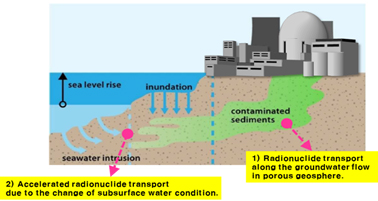방사성폐기물 관리 분야 | Most of nuclear power plants (NPP)
페이지 정보
2017.03.07 / 3,407관련링크
본문
Most of nuclear power plants (NPP) and their yard storage facilities are located on or close to the shoreline, because the nuclear power plants need for cooling water. As a fission product (90Sr, 137Cs, or 99Tc), radionuclides are often stored in a large water-filled tank of NPP facility at or near ground surface level. In a case of severe accident, the radionuclides may leave the storage sites and transport in the subsurface environment in which nearby seawater can introduce through shattered fractures and cause the salinization of original groundwater aquifers. Changes in porewater salinity may trigger ion exchange and dissolution-precipitation reactions that will affect the solubility and mobility of radionuclides associated with subsurface sediments.
Objectives are released radioactive 90Sr into the groundwater due to wreck of storage tanks can be highly mobile and transport behavior of 90Sr will change depending on the salinity degree. In this study, 90Sr was selected as the target radionuclide because of its sensitive sorption behavior via weakly bound outer-sphere surface complexes at the solid water interface. Therefore, the objective of this study was to investigate transport behavior of 90Sr through subsurface sediment at different degree of ionic strength assuming seawater intrusion in groundwater



